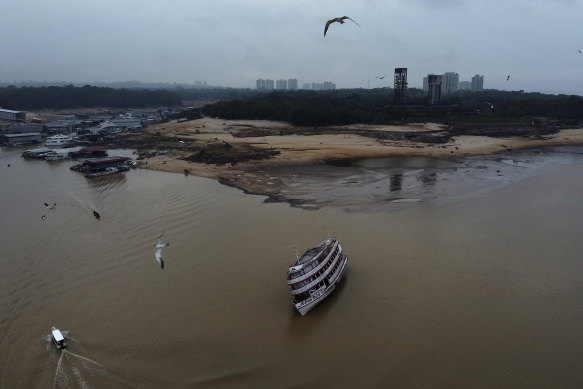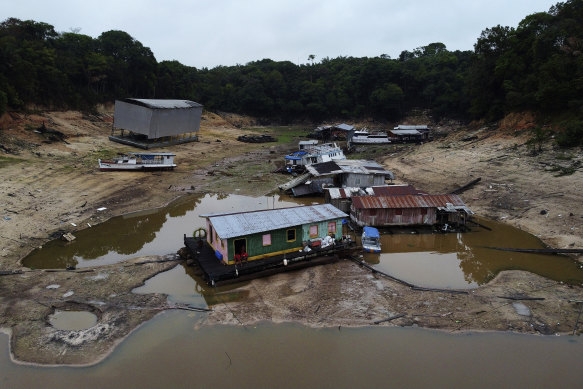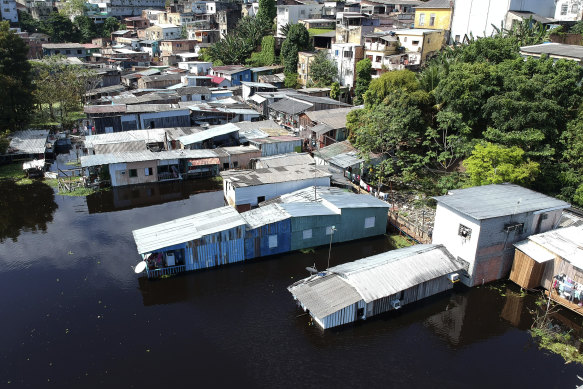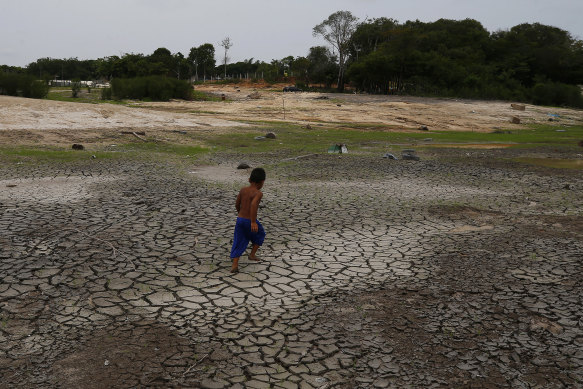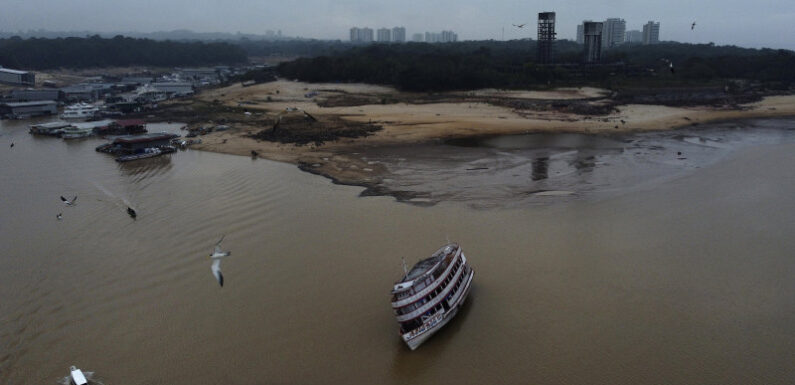
Save articles for later
Add articles to your saved list and come back to them any time.
Brasilia: The Negro River, the Amazon’s second-largest tributary, has reached its lowest level since official measurements began near Manaus 121 years ago. The record confirms that this part of the world’s largest rainforest is suffering its worst drought, just a little over two years after its most significant flooding.
On Monday morning, the water level in the city’s port went as low as 13.5 metres, down from 30.02 metres registered in June 2021 – its highest level on record. The Negro River drains about 10 per cent of the Amazon basin and is the world’s sixth-largest by water volume.
A boat is stuck in the Negro River during a drought in Manaus, Amazonas state, Brazil, on Monday. The high rises of the Manaus CBD are visible in the background.Credit: AP
Madeira River, another main tributary of the Amazon, has also recorded historically low levels, causing the halt of the Santo Antonio hydroelectric dam, Brazil’s fourth largest.
Throughout the Brazilian Amazon, low river levels have left hundreds of riverine communities isolated and struggling to access drinkable water. The drought also has disrupted commercial navigation that supplies Manaus, a city of 2 million with a large industrial park.
Manaus is the largest city and capital of Amazonas, the state hit hardest by the drought. In late September, 55 of its 62 municipalities entered states of emergency due to the severe drought.
“There is no more water to go through. Navigation is over,” boatman Cledson Lopes Brasil said.
Boats and houseboats are stuck in a dry area of the Negro River during a drought in Manaus, Amazonas state, Brazil.Credit: AP
Brasil operates in Marina do Davi port, a getaway to dozens of riverine communities, some of them with sandy beaches that attract tourists. The once bustling area is now surrounded by parched soil, with many boathouses left high and dry.
For a month now, Brasil has switched to a lower-powered boat, better suited for shallow waters. Still, he can’t reach most communities along Taruma-Açu, a tributary of the Negro River. Some riverine dwellers must walk up to three hours to reach their houses, and tourism has stopped altogether.
Manaus and other nearby cities are also suffering from high temperatures and heavy smoke from nearby man-caused fires for deforestation and pasture clearance. The drought is also the likely cause of dozens of river dolphin deaths in Tefe Lake, near the Amazon River.
This is a startling contrast to July 2021, when Negro River waters took over part of the Manaus downtown area. The historic flood, which also ruined crops of hundreds of riverine communities, lasted for about three months.
Once-in-a-century floods in Manaus, Brazil, in June 2021.Credit: AP
Negro River ends near Manaus, where it converges with the Amazon River, which is called the Solimoes River in Brazil upstream from this confluence. In Brazilian maps, this marks the beginning of the Amazon, with Negro as the second main tributary. In international maps, however, the Amazon River begins in Peru.
Philip Fearnside, an American researcher at the Brazilian National Institute of Amazonian Research, a public agency, expects the situation to deteriorate, both during the ongoing event and in the future with increasing frequency and severity of similar events with climate change.
He said surface water in the eastern equatorial Pacific Ocean was now warmer than during the “Godzilla” El Niño of 2015-2016 and was expanding.
A boy walks across a dry, cracked area of the Negro River near his houseboat in Manaus. The river reached its lowest level in more than 120 years on Monday.Credit: AP
In the Amazon, these Pacific warming events primarily lead to droughts in the northern part of the region.
Moreover, a warm water patch in the tropical North Atlantic Ocean is causing drought in the southern part of the Amazon, similar to what happened in 2005 and 2010, according to researchers.
“The forecast is for the start of the rains to be delayed compared to normal, and for a drier-than-normal rainy season,” Fearnside said.
“This could result not only in extreme low water this year, but also low levels in 2024. Until the rainy season begins in the basin, the situation that is already underway should worsen.”
AP
Most Viewed in World
From our partners
Source: Read Full Article
